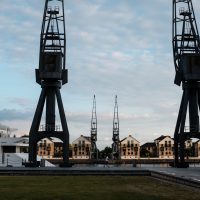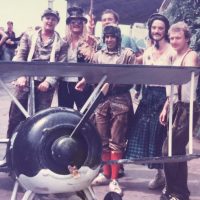
Forgotten Stories
The smells of Silvertown
Factories brought employment into the neighbourhood, and with them came the smell. Journalist and historian Colin Grainger asked people who lived and worked around the Royal Docks for their memories of its malodorous manufacturing heyday and other exotic aromas.
The Royal Docks area has a rich history in every sense – literally. A candidate for the worst smell in the Royal Docks community must have been the Rotunda. Or, as most of us locals knew it and still know it, the Iron Lung. You had to catch your breath and have lungs of steel to survive having a pee in this Grade II-listed Victorian cast-iron urinal weighing over a tonne. Since shortly after World War II, it was used by generations of dockworkers and pub goers.
The gentleman’s pissoir by C S McDowell is the only surviving circular public urinal in London, and was listed in 1983. It used to stand outside the Connaught Tavern – now known as Fox@Connaught – but in the early 1990s it mysteriously disappeared.
People in Newham have wanted to know for nearly 25 years what happened to one of their local landmarks. It was said to have been admired by the Americans who wanted it as a tourist attraction. Rumours also abounded that the circular structure had been demolished.
But now the answer to the question, “Who has taken the pissoir?” can be revealed.
The Royal Docks area has a rich history in every sense – literally.
After the closure of the docks in the 80s, the Iron Lung gradually deteriorated, and Newham Council eventually sold it off to the now-defunct London Docklands Development Corporation for £1. The body received bids for the pissoir, including interest from the USA. Back in the 60s, 70s and 80s, many London buses and indeed London Bridge was sold to the States.
However, it was discovered still close to home. A GLA spokesperson confirmed that it is currently stored on GLA land in the Royal Docks, where it has been since being restored. It is apparently secure within a container to protect it until a future home can be found for it and is regularly inspected by the GLA’s managing agents.
Many locals now believe it should be returned to the Newham docks waterfront, in the same way that the cranes have been kept as part of the landscape. Ted Demmon, from Custom House, said: “I really miss that aroma! It was something awful. It would be great to get it back into the area.” And Alfred Wright remembered: “The first time I used it, I couldn’t get rid of that smell for three days.”
I couldn’t get rid of that smell for three days.
Alfred Wright
A close second, or even I would argue top, in the awful smell stakes was the waft from the Ziff Meats slaughterhouse in Custom House. The firm dealt with meat wholesale and meat products and was registered in 1957 in Tollgate Road, on the borders of Custom House and Beckton. The smell could be detected as far north as Manor Park, and across all of the Royal Docks neighbourhoods – Custom House, Canning Town, Beckton, North Woolwich and Silvertown – depending on the direction of the wind.
Even though Ziff Meats closed in 1997, locals can still smell and almost gag with the memories of the aroma. Steve Harris, now in his 60s and from Custom House, said, “The smell was so nauseating. Made you want to throw up. Sometimes we would find some dead animal parts like bones or horns that had fallen from lorries.”
Bob Cutting said, “Years ago the area used to be plagued by a really vile smell all over the place. It seemed to permeate everywhere. It was the abattoir Ziff Meats and, Jesus, what a whiff! It’s gone now, but many a horse met with a very sticky end there as they used to render them down to glue.”
Terry Myers, 73, from North Woolwich but now living in Scotland, said: “It’s a close call between the slaughterhouse and John Knight’s really. Both smells were like a mix between the worst things you have ever smelt in your life. I’d go for Knight’s factory.”
Both smells were like a mix between the worst things you have ever smelt in your life.
Terry Myers
John Knight’s was another truly awful pong that gagged thousands of Royal Docks residents over many years. John Knight & Sons Soap Works was a family business that made affordable soaps, oils and candles. They also supplied high-quality soaps to the King and the rest of the royal family.
John Knight had begun making candles in 1810, and then expanded to manufacture soaps and oils. In 1817, the soap factory began in Wapping, and in 1880 the factory relocated to Silvertown, distributing their products using horse-drawn carts.
By 1922, the company was an associate of Lever Brothers. By 1959, it was employing 1,200 people in Factory Road making soap, glue, tallow, fertilisers, and dripping. It was now a subsidiary of the massive Unilever organisation.
But, in Silvertown, we had to live with the smell. It was a big feature of my childhood in the 50s, 60s and 70s. By the time I was at the Newham Recorder, the factory had featured many times – and not always for the right reasons.
One of the latest appeared in 2012, when the animal waste factory was hit with a record fine after locals in Silvertown and Britannia Village complained of the vile stench. The animal rendering plant was fined £120,000 and ordered to pay £66,000 costs – believed at the time to be the biggest ever achieved by a local council.
It was their third prosection. Councillor Unmesh Desai said at the time: “Businesses should not be carried on at the expense of local residents. Our residents have the right to enjoy their lives in peace without a nuisance.” Locals told of their feelings on social media. Ted Jenkins said, “It always smelt something horrible. I remember lorries going round butcher’s shops collecting the bones.” And Maureen Hawken echoed Bill’s comment, “It is a smell you can never forget.” The factory moved to Dagenham in July 2017.
One worker who did not want to be named remembered, “I worked on the lorries collecting butcher’s waste. In the winter, it was a good job. But in the summer the dolly bins were disgusting – full of maggots and stinking.” He said he had four showers a day.
The beautiful Thames Barrier Park with the view of the unofficial eighth wonder of the world was created.
Colin Grainger
I’d like to add one more personal memory. My late mother Lily worked at P R Chemicals in Silvertown as company secretary for many years. It was officially recognised as one of the most polluted sites in Britain many years later. Pollutants spilled out everyone. The smell was like nothing I had or have experienced: choking, gasping – but you got used to it.
When the firm closed and it was identified, the site had to undergo about 25 different layers of decontamination by men wearing special suits, on a site I had played on and where people worked. The numerous layers of concrete and such like were laid. And then the beautiful Thames Barrier Park with the view of the unofficial eighth wonder of the world was created. The ugly duckling became a beautiful swan!


